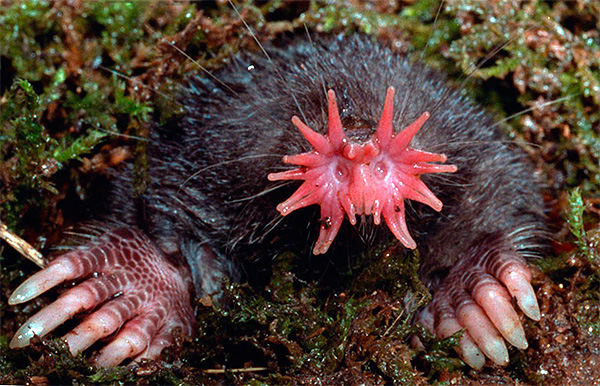
If you open any popular list of the most amazing, incredible, or even “ugliest” animals on the planet, then almost certainly the star-mole mole will be mentioned in it. First of all, thanks to its nose, which is so unique in its appearance that it is even difficult to describe. You need to see him.
Below the photo shows the mole of the starfish, it is also the star-snout (Condylura cristata):

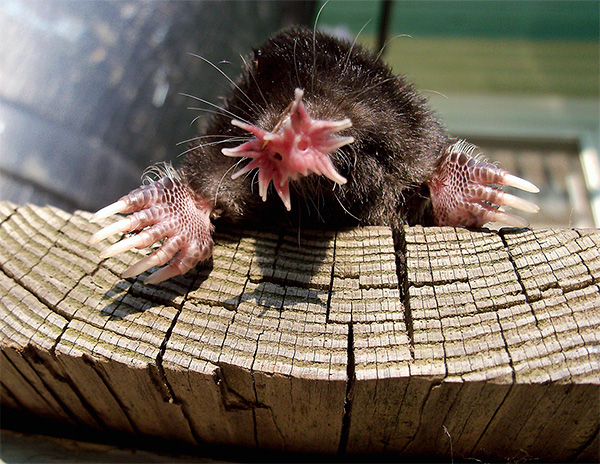

Those little tentacles that you see in the above photographs are not an anomaly, but a real nose of an absolutely normal healthy representative of this species of moles. It was such a star-like nose that made the animal a celebrity among fans of wildlife phenomena.
However, this nose attracts the attention of not only avid users of extravagant Internet users, but also serious pundits. The star-mole helps them to study the subtleties in the work of the senses in animals.
Starworm Nose and Its Purpose
If it weren’t for the characteristic outgrowths, the nose of a mole-starred mole would have been a completely normal and unremarkable nose. For example, the following photo shows an ordinary European mole:

And here is the mole of the starfish:
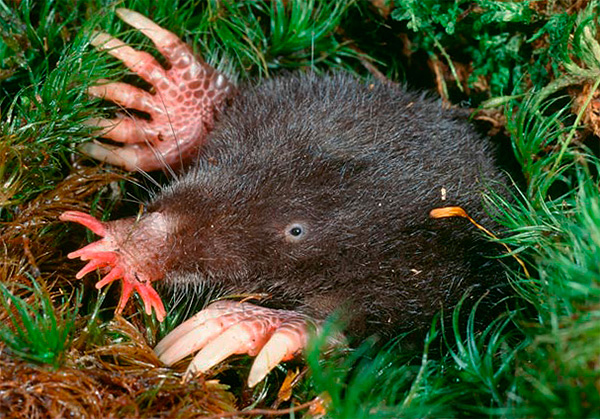
In general, the appearance of these animals is largely similar, and only the nose makes one of them an original that attracts universal attention.
The main feature of the nose of the mole ratfish is special elongated skin growths located on the sides of the nostrils. There are 11 of them on each side, and most interestingly, they are all mobile, moving with the help of muscles, being controlled by the nervous system of the animal.
Each of the outgrowths is abundantly crammed with nerve endings, making it a very effective organ of touch. Touching such a “probe” to any object, the mole manages to evaluate its temperature, mobility, hardness and, most importantly, the edibility of the object in a split second.
It is interesting
Studies show that a mole of a star-carrier is enough 8 milliseconds to use his nose to evaluate the suitability of an object for food. Today it is one of the fastest analyzers in the animal kingdom, and the Guinness Book of Records calls the star-mole mole the fastest mammal hunter (not by speed of movement, but by speed of hunting). An animal can check up to 13 different objects per second.
The human eye is not able to follow the movements of mobile outgrowths, and the use of high-speed cameras is necessary to study their work.
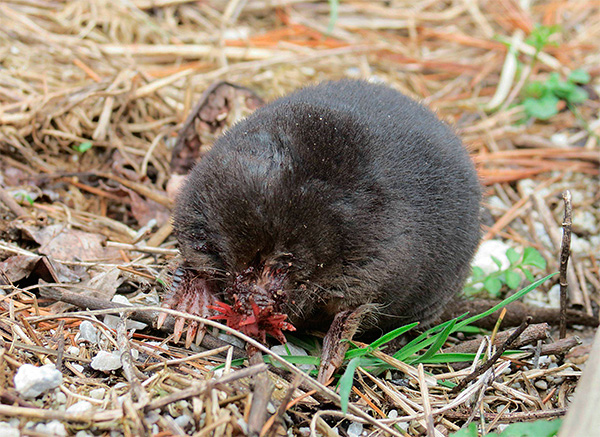
Outgrowths on the nose of the starfish (scientists call them tendrils) are constantly in motion, feeling the surfaces located close to them. Since all such "tentacles" are directed centrifugally in different directions from the nostrils, they create a star-shaped shape of the nose, and this "star" has a diameter of only about a centimeter and, for example, is smaller in size than the nail on the finger of an adult man.
Nevertheless, the total surface area of the skin on the tendrils is approximately 8 times larger than the surface of the skin on the nose of any other moles, which provides the starship with an advantage in the speed and thoroughness of the survey of the territory compared to its other relatives.
On a note
The area of the sensitive part of the nose of a European mole is about 0.11 square meters. centimeter, in the stargazer it reaches 0.92 square meters. cm.
In this case, the sensitivity of different parts of the nose of the animal varies. The eleventh, smallest inner pair of outgrowths is most sensitive, and the remaining 10 pairs work in the “touching eyes” mode, studying the situation and sending the 11th highly sensitive pair for a more thorough study of the object.
In the photo you can count the pairs of outgrowths on the nose of the molester:
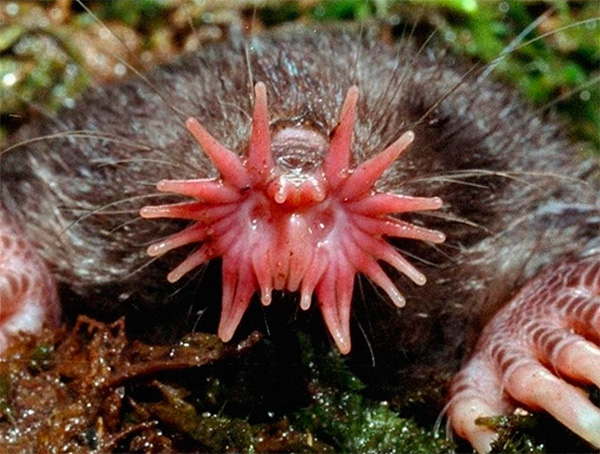
The most sensitive of them is the one whose outgrowths are the shortest, located in the center below.
Interestingly, the sensitive outgrowths in the starfish work in the same mode as the eyes of various mammals when they perform saccades (saccades are called coordinated eye movements that occur in the same direction at the same time). Due to the constant movement of outgrowths, the mole can evaluate the surface structure of any object in much the same way as a person would examine it with his eyes. So, the animal with lightning speed can figure out if there is an insect in front of it, or just a lump of earth.
At the same time, tendrils do not smell and are not able to catch prey. Everything that they do is simply perceptible, and their mechanical sensitivity is so great that, touching the surface, the star-mole can sense soil vibrations caused, for example, by an insect that is still far from it.
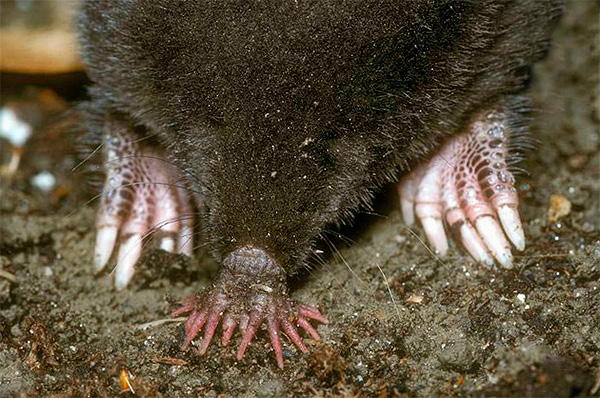
It is interesting
Each mobile outgrowth on the nose of the mole ratfish is covered with a unique epidermis, which is not found in any other mammals. The entire “star” on the nose of the star-fly carries more than 25 thousand tiny papillae with a diameter of about 50 micrometers, and each such papilla is pierced by nerve endings. As a result, the entire organ is about 6 times more sensitive, compared with the potential sensitivity of the fingertips on the hands of a person.
It is also interesting that individual receptors on the mobile outgrowths of a star-bearing mole are sensitive to rubbing, but do not respond to pressure. Others, on the contrary, are sensitive specifically to pressure. All of them are mixed up on the surface, and therefore the animal equally well feels any kind of touch to its "star".
Directly at work, the nose is a constantly moving organ. The star-shaped mole itself moves very quickly, but in the course of its movement, it manages to probe almost every square millimeter of the surface of its passage underground. Given that there is no light here, the animal can only rely on the sense of smell and sensitivity of the outgrowths themselves.
As soon as the mole stumbles upon something similar to prey with its “tentacles”, it immediately carefully and very quickly feels it, and if it really turns out to be a living creature, it bites and tries to eat. As a rule, he succeeds.

It is interesting
It is also suggested that the starfish nose can pick up the electrical impulses created by contracting the muscles of the potential victim, which makes it easier for the mole to detect food.
The appearance of the animal
If we disengage from the unusual shape of the nose and look at the appearance of the mole-stargazer as a whole, you can notice its similarity with other representatives of the order of insectivorous mammals.
For example, here is another photograph of a molehill:
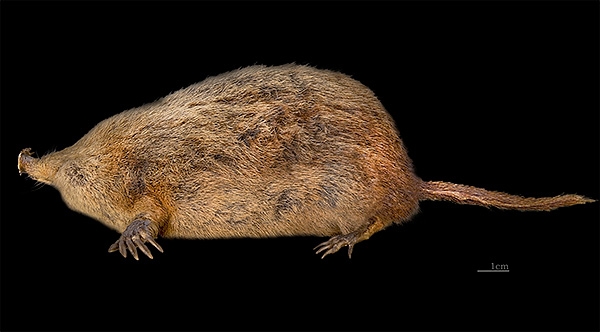
Compare it to a desman:
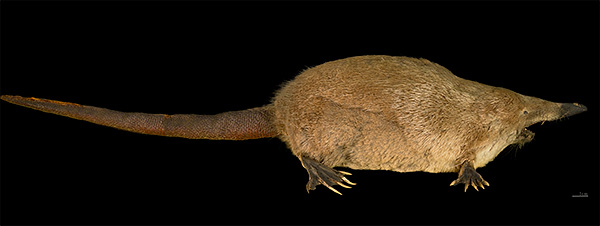
The outward resemblance is quite obvious.
The body length of an adult mole rat is about 10-12 cm without tail length, and weight is about 50-70 grams. The tail of the starfish is slightly longer than that of other moles, and reaches a length of about 7-8 cm. It is believed that the main function of the tail is to store fat - by winter it increases markedly in diameter.
It is noteworthy that the color of moles caught in nature is dark brown or black, and that of museum exhibits is simply brown. This is due to the fact that a large amount of earth is poured into the fur of the animal during its underground walks, making its fur darker. When a stuffed animal is made from a mined specimen, the wool is washed and cleaned, and it acquires its natural color.
In the photo - a caught star-shaped mole in a man’s hand:

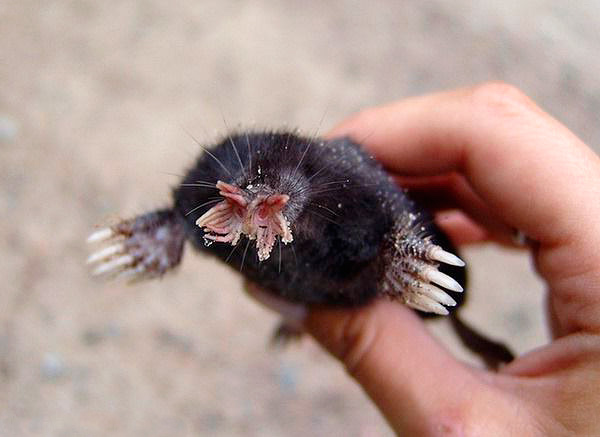
The forelegs of the star-mole mole are armed with powerful claws - especially for raking rubble in the passages and laying new tunnels.There are also impressive claws on the hind legs of the mole, but they are smaller in size and are designed to push the ground back.
By coordinated movements of the front and hind legs, the mole quickly moves large volumes of land from the place where it is laying a new tunnel:
- With his forepaws, the animal tears off clods of earth from the formation and pushes them under itself;
- Then it moves forward a little, crawling through the formed pile;
- Then he pushes the earth off with his hind legs.
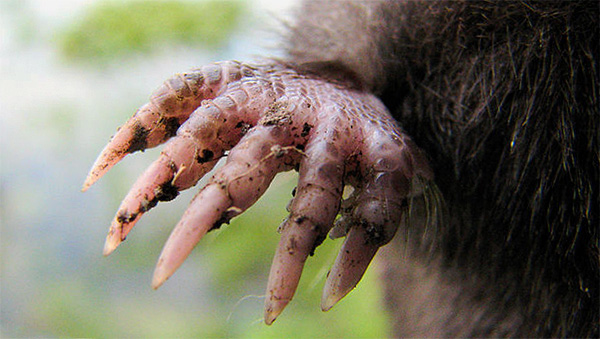
The eyes of the star-mole are very small, but they are not covered with skin, and they are clearly visible. They poorly distinguish the contours of objects, and respond mainly to light and darkness.
On the whole, outwardly, the mole is a star-bearing star, with the exception of its characteristic nose, in many respects resembles a European mole, but is somewhat smaller in size.
Where does the star-mole live?
Starfish moles are common only in the New World. Their habitat extends from the south of the eastern coast of the United States (Georgia and Florida) to Manitoba and Labrador in Canada. In the west, this species occurs up to the western border of the Great Lakes. Due to this, by the way, the mole starfish is considered the most northern American mole.
Everywhere throughout their range, star-bearing moles prefer to settle in moist, swampy places, on damp meadows, and also on the coasts of various water bodies. They avoid dry steppes and forests.
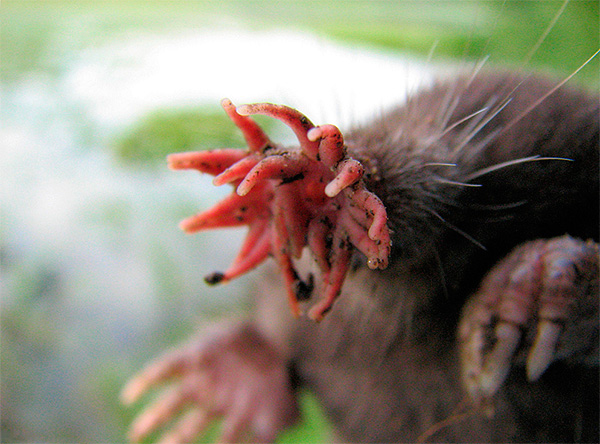
On a note
Mole-pointed starfish in the south of the range are slightly smaller than their northern congeners from Canada. Some scientists even distinguish two subspecies of the mole ratfish: southern and northern.
Lifestyle & Nutrition
In its way of life and hunting habits, the star-mole is something between a typical mole and a muskrat. He spends most of his time inspecting his underground passages and collecting worms, insects, and any other living creatures, down to small frogs and mice. If the moves do not bring the right amount of food for a long time, then the mole is actively digging new ones.
Zvezdoral is very mobile. The assumption that if he cannot run fast on the surface of the earth is erroneous, which means that he is generally clumsy. In its underground tunnels, it moves faster than, for example, a rat runs on the surface of the earth.
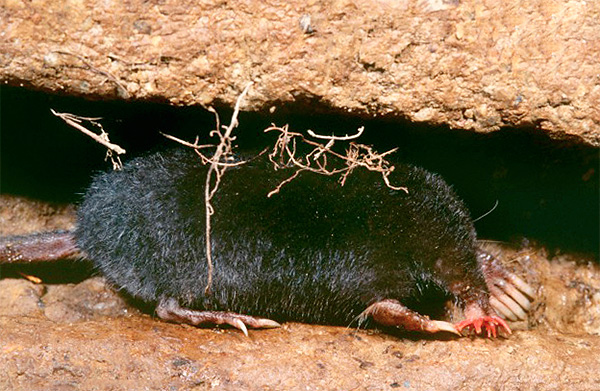
Often a mole crawls out to the surface of the earth and collects food here. Often, the star-killer makes moves in fallen foliage, directly on the surface of the earth, in the grass, and here he tries to pry off part of the plant stems from the ground with his paws, creating a clearly visible path. In the future, these peculiar paths are used by various small animals, which the mole can also catch and eat.
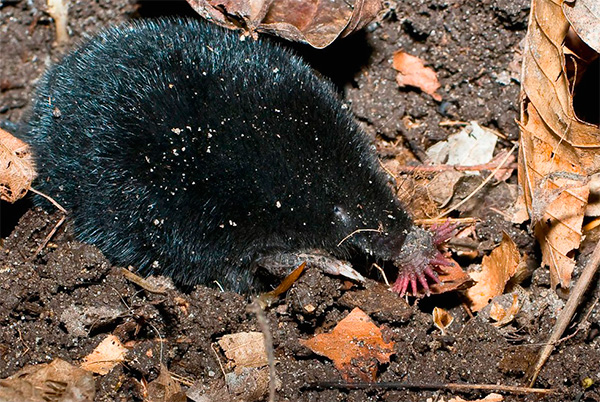

It is noteworthy that the star-mole mole swims well and dives, collecting various arthropods at the bottom of water bodies, and it can even dive and hunt under the ice. Here, under water, the mole also helps his nose. To access the pond, the starfish usually tries to lay an underground passage directly to the edge of the water.
Stargazers hunt with equal frequency both day and night. Moles do not fall into hibernation, and therefore, for normal life they need a large amount of food, even in the cold season. In winter, these animals often make passages under the snow, collecting wintering insects and their larvae here.
Like other moles, the star-snout is very voracious. In the summer, during a period of abundance of food, he can eat as much food per day as he weighs, but his usual daily rate is about 30-35 grams of food. During the day he sleeps on average 4-5 times and goes out to hunt the same number of times.
How does a mole starfish breed?
Many scientists agree that star mole rats developed partial monogamy, and a male and a female of this species, who are sexual partners, can constantly be on the same hunting site. In general, these animals are more social than other moles, generally not tolerating their own kind in the hunting area outside the mating season.
Star-bearing moles can even form unstable groups in one large hunting area. Moreover, each animal has from one to several underground chambers, which are covered with grass and used for rest.
The breeding season for starfish takes place in the spring: in the south of the range in March-April, and in the north in May-June. Pregnancy lasts about 45 days, in one litter there can be from 2 to 7 cubs (usually 3-4).
The photo below shows the small mole-starships:
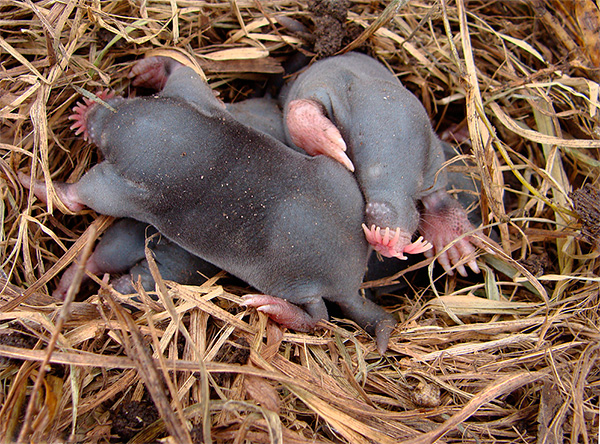
Cubs are born completely naked, with poorly developed “stars” on their noses, but they grow very quickly. Already at the age of one month, they completely switch to an adult diet, leave the nest and scatter around the periphery of the parent hunting area, exploring previously untouched lands, or occupying the territories of deceased neighbors.
At 10 months, young mole rats become sexually mature, and usually the next spring after their birth they already take part in breeding.
The average life span of a mole ratfish is 3-4 years. In captivity, some individuals live up to 7 years, but in nature a huge number of young animals die in the claws and teeth of predators.
Despite the underground way of life and an unpleasant smell, star birds hunt prey birds (falcons and owls), as well as foxes, skunks, martens, dogs, especially in the winter season, when these mole enemies are not particularly picky when choosing food. At the same time, predatory mammals often dig animals out of their feed passages located close to the surface of the earth.
Partly due to the active eating by predators, partly due to the plowing of lands and a decrease in the original habitat, the star-mole is not as numerous today as it was several centuries ago. Nevertheless, it does not belong to rare animals, and its status as a biological species does not cause any concern among specialists in the field of environmental protection.
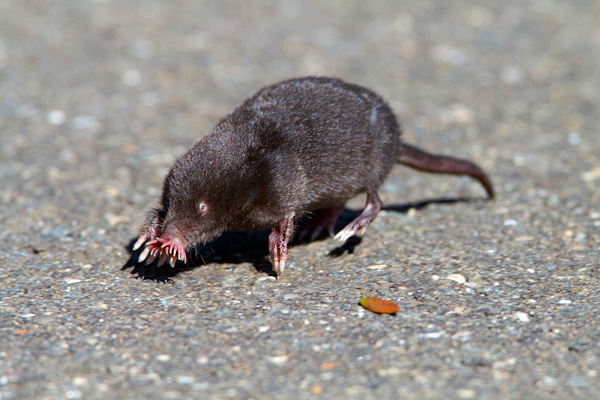
The star-mole is not a formidable pest of agriculture. The marshy biotopes that he prefers for life are not very suitable for private farming or industrial agricultural use, and therefore his and his interests overlap less often than, for example, the activity of the European mole and the interests of Russian summer residents.
In the old days, even during the period of colonial wars, mole rattleworms in small quantities were obtained by trappers because of their fur, but today the proportion of these animals in the furry stocks of minuscule. Therefore, people are interested in this mole mainly because of its unique anatomical and physiological characteristics.
An interesting video about how a star-mole mole hunts with its unusual nose
And here you can see how the starfish hunts under water




I immediately remembered the film "Resident Evil".